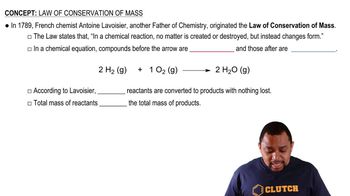Here are the essential concepts you must grasp in order to answer the question correctly.
Nuclear Reactions
Nuclear reactions involve changes in an atom's nucleus and can result in the transformation of one element into another. These reactions can be classified into types such as fusion, fission, and radioactive decay. Understanding the type of nuclear reaction is crucial for predicting the products formed, as each type follows specific rules and conservation laws.
Recommended video:
Conservation Laws
In nuclear reactions, certain quantities are conserved, including mass-energy and charge. The conservation of mass-energy states that the total mass and energy before the reaction must equal the total after the reaction. Similarly, the conservation of charge ensures that the total charge remains constant throughout the reaction, which is essential for determining the products formed.
Recommended video:
Law of Conservation of Mass
Nuclear Notation
Nuclear notation is a way to represent isotopes and nuclear reactions using symbols that include the element's chemical symbol, atomic number, and mass number. For example, uranium-235 is denoted as ²³⁵U. Understanding nuclear notation is vital for identifying reactants and products in nuclear reactions, as it provides essential information about the particles involved.
Recommended video:
Standard Notation to Scientific Notation
 Verified step by step guidance
Verified step by step guidance


